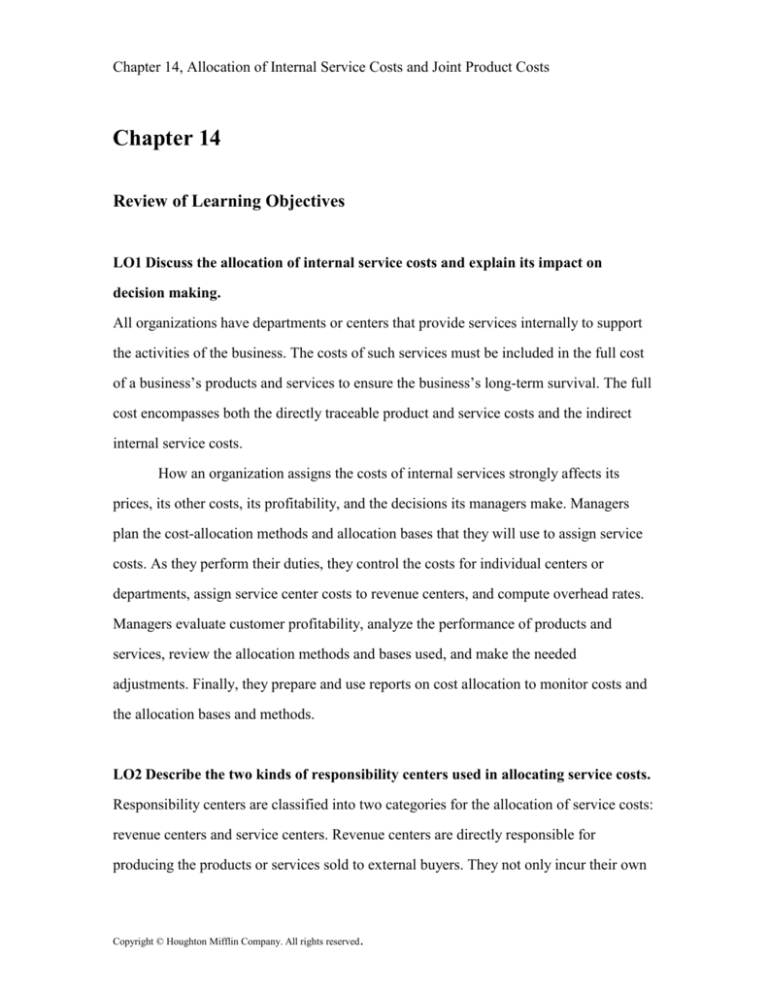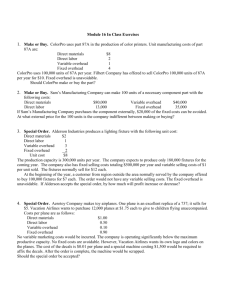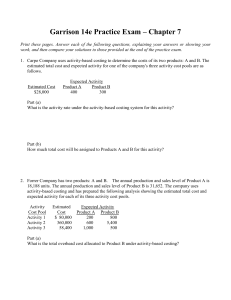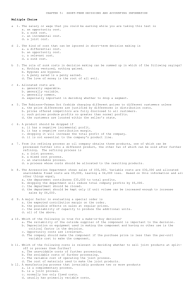
Chapter 14, Allocation of Internal Service Costs and Joint Product Costs
Chapter 14
Review of Learning Objectives
LO1 Discuss the allocation of internal service costs and explain its impact on
decision making.
All organizations have departments or centers that provide services internally to support
the activities of the business. The costs of such services must be included in the full cost
of a business’s products and services to ensure the business’s long-term survival. The full
cost encompasses both the directly traceable product and service costs and the indirect
internal service costs.
How an organization assigns the costs of internal services strongly affects its
prices, its other costs, its profitability, and the decisions its managers make. Managers
plan the cost-allocation methods and allocation bases that they will use to assign service
costs. As they perform their duties, they control the costs for individual centers or
departments, assign service center costs to revenue centers, and compute overhead rates.
Managers evaluate customer profitability, analyze the performance of products and
services, review the allocation methods and bases used, and make the needed
adjustments. Finally, they prepare and use reports on cost allocation to monitor costs and
the allocation bases and methods.
LO2 Describe the two kinds of responsibility centers used in allocating service costs.
Responsibility centers are classified into two categories for the allocation of service costs:
revenue centers and service centers. Revenue centers are directly responsible for
producing the products or services sold to external buyers. They not only incur their own
Copyright © Houghton Mifflin Company. All rights reserved .
Chapter 14, Allocation of Internal Service Costs and Joint Product Costs
traceable costs, but are also assigned the costs of other responsibility centers from which
they benefit.
Service centers provide benefits to other responsibility centers. Service centers are
also called support centers because they indirectly support the activities of the revenue
centers and other service centers. The traceable costs of a service center are first collected
and controlled by that center and then assigned to other centers based on a logical
measure or cost driver.
LO3 Use the direct method to assign service costs.
The simplest of the commonly used activity-based cost-allocation methods is the direct
method, which assigns the costs of service centers only to revenue centers. However,
because the direct method ignores the fact that service centers provide service and support
to other service centers as well as to revenue centers, the distribution of costs may not
reflect the actual use of services.
LO4 Use the step method to assign service costs.
The step method assigns service center costs to both service and revenue centers based on
descending order of use. The costs of the service center that is used most by other centers
are assigned first. The costs of the service center that is used least by other service centers
are assigned last. Managers must decide on the order of allocation. Once the costs of a
service center have been assigned, that center cannot receive any assigned costs from any
other service center. Although the step method attempts to recognize some
interdepartmental use, other methods must be used to recognize the full reciprocal usage
of services.
LO5 Describe the two-step method, the simultaneous equation method, the ability to
pay method, and the physical measures method of assigning service costs.
Copyright © Houghton Mifflin Company. All rights reserved .
Chapter 14, Allocation of Internal Service Costs and Joint Product Costs
A business that is interested in fully recognizing the reciprocal use of services among
service centers can use either the two-step method or the simultaneous equation method
of service cost allocation. Organizations that do not need precise measurements of the
internal use of services may decide to allocate service center costs based on a revenue
center’s ability to pay. Under this system, if sales dollars are used as a cost driver, a
revenue center’s actual use of service centers is irrelevant. The easiest method of service
cost allocation, physical measures, is based on the number of centers instead of on an
activity of the centers. A service center’s costs are divided by the number of centers that
use its services and assigned in equal portions.
LO6 Explain how service cost allocation relates to overhead rates.
When a revenue center applies overhead costs to the product or service it produces, either
a single departmental overhead rate or several activity-based costing (ABC) rates are
used. These rates include the overhead costs of the revenue center and any assigned
service center costs. Revenue center managers may use several activity-based rates
instead of a single departmental overhead rate to improve their ability to manage and
control different types of overhead costs.
LO7 Apply allocation methods to the costs associated with joint products.
Joint products and byproducts are produced simultaneously from a common source. Joint
products are the primary products produced. Some joint products are called byproducts
because their sales value is minor relative to the value of the other simultaneously
produced joint products. Joint costs are the common costs incurred before the separation
of joint products. The split-off point is the point in the production process at which
products first become separate, identifiable products or byproducts. Costs incurred after
the split-off point that can be traced to the individual products are called separable costs.
Copyright © Houghton Mifflin Company. All rights reserved .
Chapter 14, Allocation of Internal Service Costs and Joint Product Costs
Three methods are commonly used to allocate joint costs to products. The
physical units method assigns joint costs to products based on a physical quantity, such as
weight, volume, or units. The relative sales value method assigns joint costs to products
based on their sales value at the split-off point of production. The net realizable value
method assigns joint costs to products based on the eventual sales value of each product
less any separable costs needed to make it salable.
Copyright © Houghton Mifflin Company. All rights reserved .











